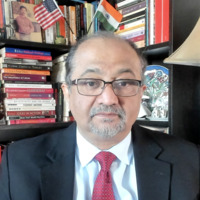
Adam Cooper
Related Authors
Muqtedar Khan
University of Delaware
Mariya Ivancheva
University of Strathclyde, Glasgow
E. Wayne Ross
University of British Columbia
danah boyd
Microsoft Research
Andrea Peto
Central European University
Albert Bastardas-Boada
Universitat de Barcelona
David Seamon
Kansas State University
Donna Alvermann
The University of Georgia
Armando Marques-Guedes
UNL - New University of Lisbon
Eitan Grossman
The Hebrew University of Jerusalem
InterestsView All (7)










Uploads
Papers by Adam Cooper
unpacked, and its relevance is discussed for contexts like South Africa, places where young people have no living memory of apartheid and their lives are emphatically segregated along lines of class, race, gender, and age. Dialogic learning helps to transgress these social divisions, as it involves multiple perspectives existing simultaneously, as people are forced to consider and reflect on these different positions, including their own and those of others. This form of learning and reflection may subsequently catalyze personal transformation. Despite these benefits, qualitative research indicates that interpersonal interactions between South African youth and adults, such as teachers and parents, do not contain a great dialogue through which different parties interact verbally. At the institutional level, authoritative school-based norms and discourses, often dominated by forms of “whiteness,” militate against dialogical learning. Some examples of dialogic learning have occurred through participatory research, studies which are explored in the chapter. These pieces of research engage young people with regard to issues such as xenophobic violence, masculinities and gang involvement, and participatory HIV/AIDS curriculum development. The value of this kind of research lies in the safe spaces that are created through the research process, as young people’s linguistic resources and perspectives are valued. There is also immense benefit for both parties in the reciprocal nature of the exchanges, whereby researchers are educated in terms of the lives of youth, and young people are able to reflect on their own perspectives, emotions, and worldviews, as well as those of others.
increasingly racialized. In the post‐apartheid era, the values underpinning the constitutional democracy have shaped child justice policy within a human rights discourse and progressive notions of restorative justice. However, whilst the contemporary
policy framework is couched in an admirable restorative justice paradigm, rampant economic and social inequality remains, due to the legacies of colonialism and apartheid. Thus, it is the argument of this chapter that the restorative justice
approach can only succeed, in a sustainable fashion, if it forms part of – and is able to contribute towards – a broader redistributive justice strategy in the medium‐ to long‐term future.
unpacked, and its relevance is discussed for contexts like South Africa, places where young people have no living memory of apartheid and their lives are emphatically segregated along lines of class, race, gender, and age. Dialogic learning helps to transgress these social divisions, as it involves multiple perspectives existing simultaneously, as people are forced to consider and reflect on these different positions, including their own and those of others. This form of learning and reflection may subsequently catalyze personal transformation. Despite these benefits, qualitative research indicates that interpersonal interactions between South African youth and adults, such as teachers and parents, do not contain a great dialogue through which different parties interact verbally. At the institutional level, authoritative school-based norms and discourses, often dominated by forms of “whiteness,” militate against dialogical learning. Some examples of dialogic learning have occurred through participatory research, studies which are explored in the chapter. These pieces of research engage young people with regard to issues such as xenophobic violence, masculinities and gang involvement, and participatory HIV/AIDS curriculum development. The value of this kind of research lies in the safe spaces that are created through the research process, as young people’s linguistic resources and perspectives are valued. There is also immense benefit for both parties in the reciprocal nature of the exchanges, whereby researchers are educated in terms of the lives of youth, and young people are able to reflect on their own perspectives, emotions, and worldviews, as well as those of others.
increasingly racialized. In the post‐apartheid era, the values underpinning the constitutional democracy have shaped child justice policy within a human rights discourse and progressive notions of restorative justice. However, whilst the contemporary
policy framework is couched in an admirable restorative justice paradigm, rampant economic and social inequality remains, due to the legacies of colonialism and apartheid. Thus, it is the argument of this chapter that the restorative justice
approach can only succeed, in a sustainable fashion, if it forms part of – and is able to contribute towards – a broader redistributive justice strategy in the medium‐ to long‐term future.